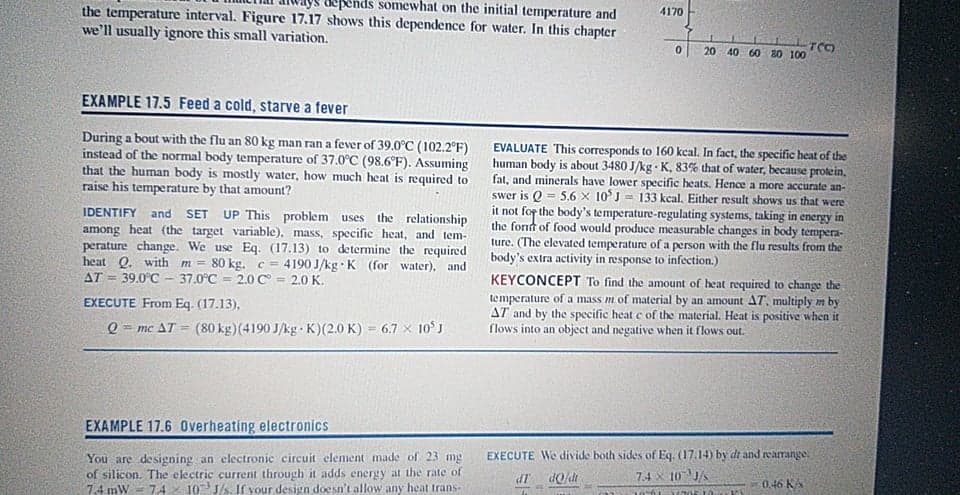During a bout with the flu an 80 kg man ran a fever of 39.0°C (102.2°F) instead of the normal body temperature of 37.0°C (98.6°F). Assuming that the human body is mostly water, how much heat is required to raise his temperature by that amount?
During a bout with the flu an 80 kg man ran a fever of 39.0°C (102.2°F) instead of the normal body temperature of 37.0°C (98.6°F). Assuming that the human body is mostly water, how much heat is required to raise his temperature by that amount?
College Physics
10th Edition
ISBN:9781285737027
Author:Raymond A. Serway, Chris Vuille
Publisher:Raymond A. Serway, Chris Vuille
Chapter10: Thermal Physics
Section: Chapter Questions
Problem 26P: The density or gasoline is 7.30 102 kg/m3 at 0C. Its average coefficient of volume expansion is...
Related questions
Question
If the person in Example 17.5 is a Terminator machine that is composed of 99.99% Aluminum. How much energy is required to raise his temperature on the said problem

Transcribed Image Text:ends somewhat on the initial temperature and
the temperature interval. Figure 17.17 shows this dependence for water. In this chapter
we'll usually ignore this small variation.
4170
TC)
20 40 60 30 100
EXAMPLE 17.5 Feed a cold, starve a fever
During a bout with the flu an 80 kg man ran a fever of 39.0°C (102.2°F)
instead of the normal body temperature of 37.0°C (98.6°F). Assuming
that the human body is mostly water, how much heat is required to
raise his temperature by that amount?
EVALUATE This corresponds to 160 kcal. In fact, the specific heat of the
human body is about 3480 J/kg K, 83% that of water, because protein,
fat, and minerals have lower specific heats. Hence a more accurate an-
swer is Q = 5.6 x 10°J = 133 kcal. Either result shows us that were
it not for the body's temperature-regulating systems, taking in energy in
the fornt of food would produce measurable changes in body tempera-
ture. (The elevated temperature of a person with the flu results from the
body's extra activity in response to infection.)
IDENTIFY and
SET UP This problem uses the relationship
among heat (the target variable), mass, specific heat, and tem-
perature change. We use Eq. (17.13) to determine the required
heat Q. with m = 80 kg. c = 4190 J/kg K (for water), and
37.0°C = 2.0 C = 2.0 K.
KEYCONCEPT To find the amount of heat required to change the
temperature of a mass m of material by an amount AT, multiply m by
AT and by the specific heat c of the material. Heat is positive when it
flows into an object and negative when it flows out.
AT
%3D
39.0°C
EXECUTE From Eq. (17.13),
0 = mc AT =
(80 kg) (4190 J/kg · K)(2.0 K) = 6.7 x 10°J
EXAMPLE 17.6 Overheating electronics
EXECUTE We divide both sides of Eq. (17.14) by dt and rearrange:
You are designing an electronic circuit element made of 23 mg
of silicon. The electric current through it adds energy at the rate of
7.4 mW
dO/dt
7.4 X 10JA
7.4
10 J/s. If your design doesn't allow any heat trans-
0.46 KA
Expert Solution
This question has been solved!
Explore an expertly crafted, step-by-step solution for a thorough understanding of key concepts.
This is a popular solution!
Trending now
This is a popular solution!
Step by step
Solved in 2 steps

Knowledge Booster
Learn more about
Need a deep-dive on the concept behind this application? Look no further. Learn more about this topic, physics and related others by exploring similar questions and additional content below.Recommended textbooks for you

College Physics
Physics
ISBN:
9781285737027
Author:
Raymond A. Serway, Chris Vuille
Publisher:
Cengage Learning

College Physics
Physics
ISBN:
9781305952300
Author:
Raymond A. Serway, Chris Vuille
Publisher:
Cengage Learning


College Physics
Physics
ISBN:
9781285737027
Author:
Raymond A. Serway, Chris Vuille
Publisher:
Cengage Learning

College Physics
Physics
ISBN:
9781305952300
Author:
Raymond A. Serway, Chris Vuille
Publisher:
Cengage Learning


Physics for Scientists and Engineers
Physics
ISBN:
9781337553278
Author:
Raymond A. Serway, John W. Jewett
Publisher:
Cengage Learning

Physics for Scientists and Engineers with Modern …
Physics
ISBN:
9781337553292
Author:
Raymond A. Serway, John W. Jewett
Publisher:
Cengage Learning

Principles of Physics: A Calculus-Based Text
Physics
ISBN:
9781133104261
Author:
Raymond A. Serway, John W. Jewett
Publisher:
Cengage Learning